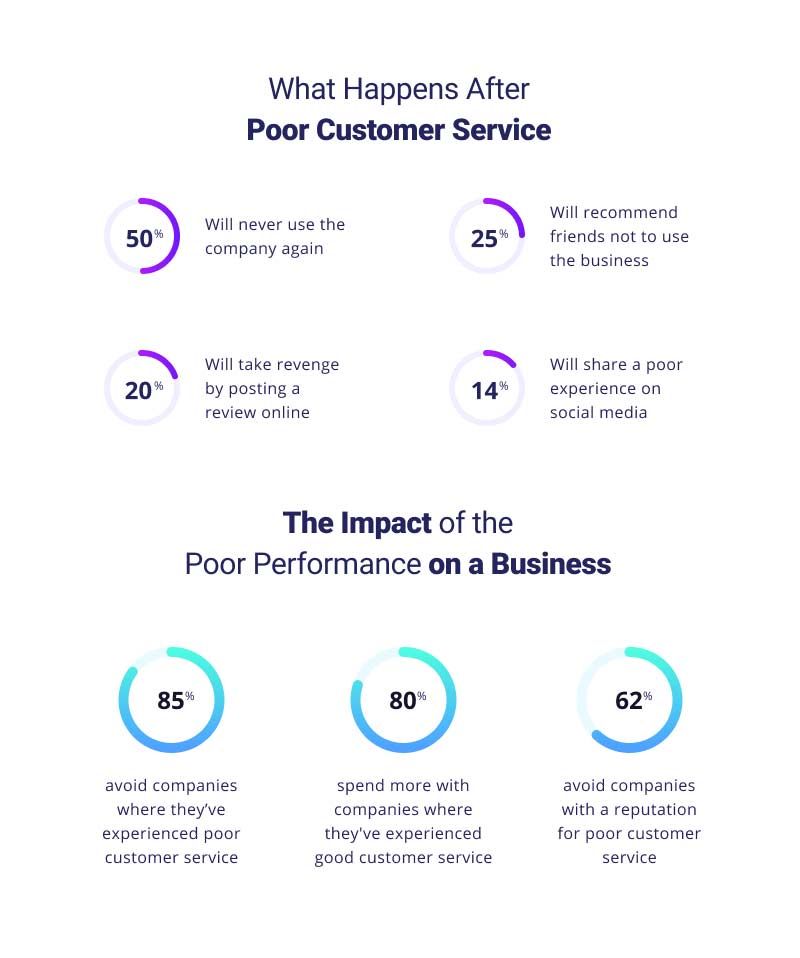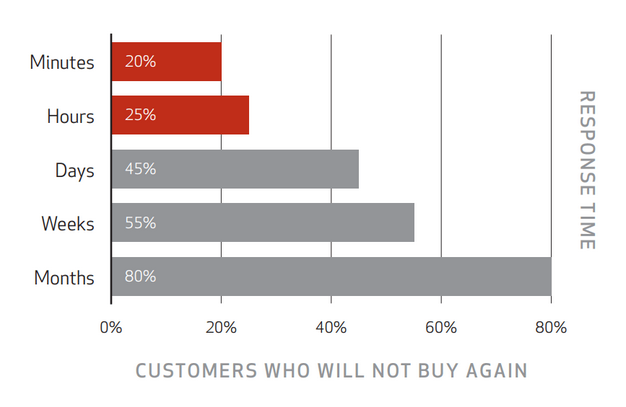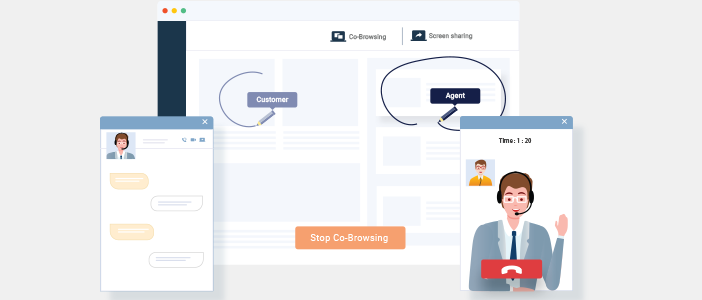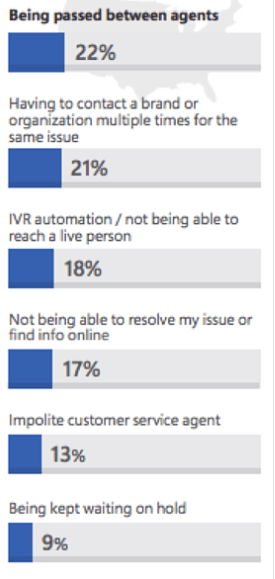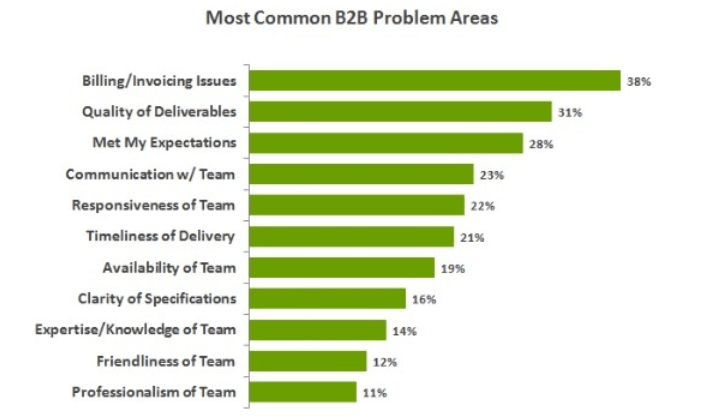“A satisfied customer is the best business strategy of all.” – Michael LeBoeuf
Customer satisfaction is the key metric to measure your customer happiness. Having superior customer satisfaction can create competitive differentiation as well as build your brand image.
Not only that, customers are the best judge for what your company offers. However, businesses go through a constant struggle to handle customer service problems and deliver a great service experience, as it is indisputably better to have satisfied customers than dissatisfied customers.
79% of consumers who shared complaints about poor customer experience online had their complaints ignored. And after one negative experience, customers will never do business with that company again.
Hence, identifying customer service issues and proactively solving them is crucial to build long-term relationships with clients and increase customer retention.
Why solving customer service problems is crucial?
Every company faces problems but what is more important is how effectively they are putting efforts to resolve them. Solving customer service problems is crucial as it impacts other business areas. Businesses need to more customer-focused and align their services that delight customers by solving their problems effectively.
Delivering an unforgettable experience helps businesses to fulfill key objectives like:
Acquire more customers
When you go the extra mile and deliver great customer service, it improves the satisfaction level of your clients. Happy customers can refer to you more customers through word of mouth which helps increase your customer base and increase sales conversion significantly. This will eventually strengthen the customer retention system of the business.
Cultivate customer loyalty
Offering prompt support and acknowledging their customer service problems with effective solutions they are highly impressed. Satisfied customers are more likely to be associated with you that increases customer loyalty.
Reduce customer churn
If you deliver an unpleasant service experience, customers are likely to deflect to competitors even if your product is of high quality. Offering premium customer service is an investment to your business as it reduces customer churn and increases the lifetime customer value (LTV).
The most common customer service challenges that any business can encounter
Businesses encounter several difficulties as they work to provide the products and services their customers most need. But customers often remember how a company handles a difficult experience more than what caused the issue in the first place.
We have compiled some of the most common customer service problems and their solutions respectively. The solutions can help businesses to provide a great service experience as well as turn the negative into positive ones.
- Slow response time
- Rude communication of customer service staff
- Lack of real time engagement
- Being transferred from one agent to another
- Excessive customer service automation
- No unified customer view
- Incompetent customer service staff
- Offering a wrong product
- Fail to meet commitments
- No or poor after-sales support
Let us discuss customer service issues, their causes, and solutions.
1. Slow response time
Nobody likes waiting on hold.
76% of respondents said, “Just one unpleasant contact center experience was likely to make them take their business elsewhere”.
It is clear if, given the opportunity, customers will choose companies that provide better customer service. Furthermore, they will tell their friends and family about their experience.
So, reducing hold times should be a priority.
Many companies view customer service as a function that adds expense without adding revenue; they don’t see the return on investment (RoI) in providing a better experience. But the successful ones know the importance of maximizing every opportunity to interact with customers.
Zappos, legendary known for its customer service, strives to answer 80% of its calls within 20 seconds. They view each conversation as an opportunity to build the “Zappos” brand into being about the very best customer service.
How to resolve customer service problems?
- Add live chat – Live chat allows handling multiple chats at the same time, which helps agents deliver faster responses. It reduces the queue time significantly and boosts the satisfaction level of the customers .
- Deploy AI chatbots – Leveraging bots allows you easy scalability during peak time and delivers prompt response to customers in real time. You can engage customers 24×7 even when your support agents are busy or not available.
- Have enough manpower – You can hire sufficient resources to manage conversations at ease without having clients wait for a long time. Having a strong resource back up helps in handling conversations effectively and provides immediate solutions to customer service problems.
Slow response time is always a big concern as it causes customer frustration. Sign up with REVE Chat for the best of customer service tools and boost your response time.
2. Rude communication of customer service staff
The rude support staff is the worst thing any brand can have.
When customers reach out for support, they are already worried and if the agent is communicating rudely, they have zero tolerance for such behavior. Infuriated customers impact the brand negatively. They switch companies, shout loud across social media and share with friends.
70% of the customer’s journey is dictated by how the customer feels they are being treated.
Hence, the basic principles of customer service etiquette should be integrated into every facet of your business to deliver top-quality service.
How to handle this customer service issues?
- Train your support team – Conduct training sessions to impart knowledge and enhance the soft communication skills of your staff. Training your staff on two things: using the right words while interacting with different types of customers, and how to how to politely decline a customer request.
- Provide chat scripts – You can provide live chat scripts and customer service phrases to handle conversations consistently in different circumstances.
- Practice active listening – It is one of the best ways to serve your customers. Actively listening to customers allows you to use the right empathy statements for customer service and deliver a delightful experience.
3. Lack of real time engagement
In many scenarios, customers need instant assistance and at times, live chat is not just enough. There is a need to view the problem or have a face-to-face conversation for getting the right solution.
23% of consumers seek out a face to face interaction for complicated customer service issues like troubleshooting.
It is wise to engage your customers in real time by using live customer engagement tools and improve the first contact resolution (FCR) and deliver a great service experience.
How to solve customer service problems?
- Use video & voice chat – Visual identification with video chat is far more effective than a verbal conversation. Face-to-face live video helps to identify the root cause of the issue in the first go. Further, you can deliver the right solution in the first touchpoint itself and also build trust through personalized chat.
- Collaborate with co-browsing – You can assist your customers in real time by controlling their screen and help them to fill up a complex form or application. Being able to offer real time help boosts customer satisfaction and delivers a great virtual in-person customer experience.
4. Being transferred from one agent to another
A very often customer service problem faced by many on reaching out for support is to have to spend time in being rolled among departments or agents and describing the same issue. Having to repeat the process after being transferred to a different department is so very frustrating.
Such customer support mistakes can occur when business workflows are not properly aligned with the communication channels.
How to fix the customer service issues effectively?
- Use intelligent routing – The conversations can be routed to the right department or agent having the expertise to resolve the issue effectively and reduce the number of touchpoints.
- Effective department management – You can effectively distribute the chats across the right departments in order to deliver prompt solutions. It improves customer service response time and increases the agent’s productivity.
5. Excessive customer service automation
Automation should be used primarily, not as the end goal. Excessive automation can turn you to the wrong side. Use automation to start the conversation and get the ball rolling, not to try to act in place of a person.
You can automate whatever is predictable like sales or customer service FAQs with chatbots. But the customer service challenges that require elaborative discussion should not be left over to a bot.
For more complicated interactions, such as payment disputes, 40% of customers prefer talking to a real person.
How to manage customer service problems?
- Provide alternative channels like live chat, email so that your customers can connect with the support team easily and get the right solution.
- There should be a fallback defined while designing the chatbot to connect the human agents when customers want. Balancing conversations smartly with the bot and live chat agents can reduce customer service problems.
6. Lack of unified customer view
Improper alignment between customer service and the customer journey results in inconsistent service, which frustrates the clients. Eventually, they switch the brand and all efforts in building consumer relationships are ruined.
Businesses should focus on delivering consistent omnichannel customer service across all the channels like website, social media, phone, in-app, stores, etc. It means the customer satisfied with your social support over Facebook messenger should be equally convinced with your quality of website support.
Bank of America, the renowned global bank delivers consistent omni channel service to its customers. The bank allows for everything from depositing checks to scheduling an appointment to be handled by the company’s mobile and desktop apps.
How to solve customer service challenges by going omnichannel?
- Map your customer journey to closely understand their behavior, learn their interests, and needs.
- Streamline all the customer conversations under one platform and provide a cohesive experience.
- Identify the most preferred channels and be 24×7 active across those channels to reduce average response time.
- Make use of engagement tools like live chat, chatbots, visual tools across all customer touchpoints to gain faster details of the issue and deliver first contact resolution.
7. Incompetent customer service staff
“Transparency is the new normal.” – Forbes
Customers look for transparent information about the products and services when they reach out to a brand. Having a lack of knowledgeable or untrained staff can ruin everything. Such agents act as a hindrance in delivering a good customer experience.
Businesses while implementing training practices must understand from customers’ perspective what they want to know and hear.
One way to come up with that list is to look at the most common customer problem areas.
How to resolve the customer service issues?
- Conduct product training – Ensure thorough product training sessions regularly to impart the core competencies of your product and services. Explain the product features deeply to provide a transparent understanding of the core positioning.
- Monitor conversation regularly – Evaluate the conversations to understand if the customers are provided the right and updated information. Further, it helps to decide how frequently training sessions should be conducted.
- Create FAQ page – Having a comprehensive page on the commonly asked questions can help the agents refer to that page to deliver authentic information. It can also help customers to choose self-service before they approach the support team.
8. Offering wrong products or services
Many times the customer service agents are not able to understand what the customer wants and offer the wrong product or service. The reason could be relying on reactive channels like the phone that involve lengthy and unclear conversations of what actually the customer wants. Such teams may fail to create customer value, resulting in negative impact on the bottom line.
Problem-solving relies on active listening, which is often overlooked. Using proactive channels for customer service communication can help to understand what they are looking for.
How to resolve customer service problems?
- Proactively guide customers – The live chat agents can proactively guide customers in their buying journey and offer the right product or service they are looking for.
- Gain insights from visitor analytics – You can monitor customer behavior in real time and collect valuable insights on what does the customer want.
9. Fail to meet commitments
Usually, the service providers make false commitments to the customers without realizing how acutely it can impact their brand.
Don’t make a promise to customers that you can’t keep. And if made, keep it.
Over delivering on customer expectations would raise customer satisfaction and be good for business. It develops trust and loyalty in customers and stays associated with your brand for a lifetime. To keep customers highly satisfied, you must continue to deliver more value because their expectations will keep increasing.
How can you fix the customer service challenges?
- Have a proper follow-up plan – Define a plan of action for the customer service challenges and execute it rightly. Having a specific plan of customer service problem-solving techniques makes handling easy for the agents.
- Communicate next step – There should not be a communication gap between you and the customers. It means when a customer approaches you to report the issue, acknowledge it, and provide a timeline for offering a solution. It makes them feel that their problem is looked into seriously and it will be resolved shortly.
- Go the extra mile – At times you have to put your efforts to go the extra mile for keeping your promise and exceed customer expectations. It delivers a great service experience.
- Send a token of care – You can mend up your relations with your customers by sending an apology note and a gift along with it to show how much you care and value them.
10. Poor after-sales support
For most businesses, once the sales are closed means over. They hardly bother about the experience of the customer with the product or service, if they are facing any issue with it or not?
It should not be the case. It causes a serious customer service problem if you leave your customers deserted after-sales.
Make your customers feel special after-sales by reaching out to them and help them out if you find out there is an issue.
How to handle customer service problems?
- Make regular follow-ups – It is vital to follow up with customers to understand their experience. It also shows how much you care for them and are there for them to help in case of any problem.
- Send a thank-you note – You can send personalized thankyou notes through email or tag over social media channels. It strengthens the connection and customers are happy with the overall brand experience.
Customer service problems are inevitable
Customer service issues are going to be there rather they will keep revolving. They can’t be avoided as customer expectations are shifting very fast. However, you need to have a well-tailored crisis management plan to handle the challenges effectively.
Your focus should also be on having the best customer support tools so that you can avoid some of the common service-related problems. Sign up with REVE Chat to find top-notch customer service solutions for your business.
By executing the plan and putting a good system & process in place, you can resolve the customer service challenges to a maximum extent and deliver an excellent consumer support experience.

